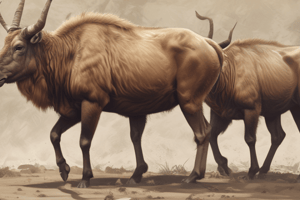Podcast
Questions and Answers
Flashcards are hidden until you start studying
Study Notes
Mammals
Characteristics
- Warm-blooded (endothermic): regulate their own body temperature
- Hair or fur present at some stage of life
- Three middle ear bones (ossicles) for hearing
- Mammary glands for milk production in females
- Brain development: neocortex present, with a large cerebral cortex
- Dental structure: teeth differentiated into incisors, canines, and molars
Body Structure
- Skeletal system: diaphragm separates chest and abdominal cavities
- Respiratory system: lungs with alveoli for gas exchange
- Circulatory system: four-chambered heart with aortic arch
- Nervous system: complex brain structure with a large cerebrum
Reproduction and Development
- Viviparity: give birth to live young (except for platypus and echidna)
- Placenta: nutrient supply from mother to fetus during pregnancy
- Lactation: production of milk for young
Types of Mammals
- Monotremes: lay eggs, produce milk (e.g., platypus, echidna)
- Marsupials: give birth to underdeveloped young, then complete development in a pouch (e.g., kangaroo, koala)
- Placentals: give birth to fully formed young, with a placenta during pregnancy (e.g., humans, dogs, cats)
Characteristics of Mammals
- Mammals are warm-blooded, meaning they regulate their own body temperature
- Hair or fur is present at some stage of a mammal's life
- Mammals have three middle ear bones (ossicles) for hearing
- Females have mammary glands for milk production
- Brain development in mammals includes a neocortex and a large cerebral cortex
- Mammals have teeth differentiated into incisors, canines, and molars
Body Structure of Mammals
- The skeletal system includes a diaphragm that separates the chest and abdominal cavities
- The respiratory system features lungs with alveoli for gas exchange
- The circulatory system has a four-chambered heart with an aortic arch
- The nervous system has a complex brain structure with a large cerebrum
Reproduction and Development in Mammals
- Mammals give birth to live young, except for platypus and echidna
- The placenta supplies nutrients from the mother to the fetus during pregnancy
- Females produce milk for their young through lactation
Types of Mammals
- Monotremes lay eggs and produce milk, examples include platypus and echidna
- Marsupials give birth to underdeveloped young, then complete development in a pouch, examples include kangaroo and koala
- Placentals give birth to fully formed young, with a placenta during pregnancy, examples include humans, dogs, and cats
Characteristics of Mammals
- Mammals are warm-blooded, meaning they regulate their own body temperature
- They have hair or fur at some stage in their lives
- Mammary glands are present, which produce milk to feed their young
- Mammals have three middle ear bones (ossicles: malleus, incus, stapes) that aid in hearing
- They give birth to live young, with a few exceptions
- The neocortex region is present in the brain, which is responsible for higher-order thinking
Types of Mammals
- Monotremes are mammals that lay eggs, but also produce milk for their young (e.g., platypus, echidna)
- Marsupials give birth to underdeveloped young, which then complete development inside a pouch (e.g., kangaroo, koala)
- Placentals give birth to fully formed young, nourished by a placenta during gestation (e.g., humans, dogs, cats)
Mammalian Body Structure
- The skeletal system has a diaphragm that separates the chest and abdominal cavities
- Teeth are differentiated into incisors, canines, and molars
- Sweat glands and sebaceous glands are associated with hair follicles in the skin and hair
Mammalian Brain and Behavior
- Mammals have a large brain-to-body mass ratio, indicating high intelligence and complexity
- They possess advanced sensory systems, including sensitive vision, hearing, and smell
- Mammals exhibit complex social behavior, including communication and culture
Studying That Suits You
Use AI to generate personalized quizzes and flashcards to suit your learning preferences.




